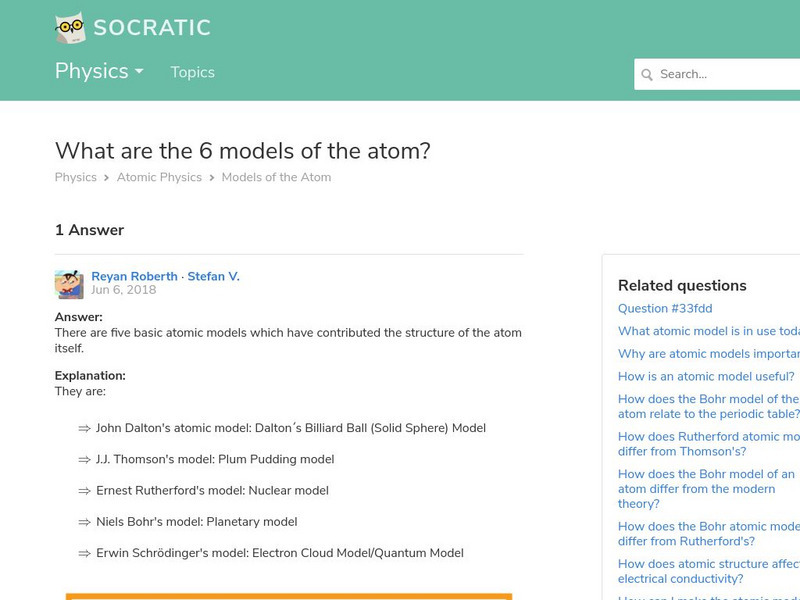Alabama Learning Exchange
Alex: Living in a "Submicro" World
This is a technology-based lesson plan designed for high school Chemistry students as an introduction to the study of the fundamental nature and structure of the atom. Students will create a publication using Desktop Publishing software...
Internet Encyclopedia of Philosophy
Internet Encyclopedia of Philosophy: Epicurus
This site from the Internet Encyclopedia of Philosophy is an excellent, detailed introduction to the philosophy of Epicurus. Divided into sections addressing his metaphysics, epistemology, ethics. Includes numerous links to related...
Utah STEM Foundation
Utah Stem Action Center: Smoke in a Bottle
Students will learn how complete and incomplete combustion is different and also how the products affect us.
Khan Academy
Khan Academy: Bohr's Model of Hydrogen
How Bohr's model of hydrogen explains atomic emission spectra.
Concord Consortium
Concord Consortium: Atom and Ion Builder
Explore how changing the numbers of protons, neutrons, and electrons affect the type of atom.
CK-12 Foundation
Ck 12: Fifth Grade Science
This customizable digital textbook covers topics related to fifth-grade science. It is Next Generation Science Standards (NGSS) aligned.
South Carolina Educational Television
Know It All: Understanding Electricity | Nasa Online
If you want to understand electricity, you first need to know a little about matter, atoms and electrons.
Concord Consortium
Concord Consortium What Is Happening When a Spark Occurs?
Activity 3 of this module investigates If moving objects have kinetic energy, do moving atoms have kinetic energy? This activity looks at how energy is related to movement of atoms.
Concord Consortium
Concord Consortium: Where Does All the Energy in an Explosion Come From?
In this module Activity 1 investigates What energy changes occur during an explosion? Students make observations of exploding balloons and a simulation, and ask questions about what occurs during an explosion, setting the scene for more...
CK-12 Foundation
Ck 12: Earth Science: Atoms to Molecules Study Guide
Understand the basic structure of atoms and molecules in the Earth's crust.
Lawrence Berkeley National Laboratory
Berkeley Lab: The Atom
Presented is an overview of atomic theory concentrating on the experiments of Ernest Rutherford.
Simon Fraser University
Chem1 Virtual Textbook: Electron Spin and the Exclusion Principle
Acting as a subtopic of the General Chemistry Virtual Textbook's section on Atoms and the Periodic Table, this site discusses electron spin with related topics, such as the Pauli exclusion principle, quantum numbers, and more.
Simon Fraser University
Chem1 Virtual Textbook: Electronegativity
Acting as a subtopic of the General Chemistry Virtual Textbook's section on Atoms and the Periodic Table, this site discusses shared chemical bonds between two elements resulting in electronegative and electropositive outcomes.
Wikimedia
Wikipedia: Amorphous Solid
This page from the Wikipedia encyclopedia on amorphous solids contains information on examples of, the difference between amorphous solids and crystalline solid, and the transition between a very viscous liquid and an amorphous solid.
Museum of Science
The Atom's Family: The Phantom's Portrait Parlor
In this activity, students investigate the atomic world by attempting to reduce paper to the size of an atom. Although students won't be able to cut the paper that small, they will gain a better understanding of how small the atom is.
Michigan Reach Out
Guess What! A Lesson About Atoms
A lesson plan outlining a very simple way to introduce students to how the structure of the atom was determined. Uses a mystery box with surprise items inside.
Science for Kids
Science Kids: Science Quizzes: Atom Quiz
A ten-question true-or-false quiz on facts about the atom.
Thomas Jefferson National Accelerator Facility
Jefferson Lab: All About Atoms
The three basic particles that make up atoms are defined and illustrated.
School of Biological and Chemical Sciences, Queen Mary University of London
Queen Mary University: Glossary
This Queen Mary University site features a glossary of chemical terms, including London forces.
Other
Socratic: What Are the 6 Models of the Atom?
Brief explanation of six major models of the atom along with illustrations. Covers the Greek model (Democritus), John Dalton, J.J. Thomson, Ernest Rutherford, Niels Bohr, and the modern electron cloud or quantum mechanics model.
Other
Atoms in Motion: All Matter Is Made of Atoms
Atoms are very, very small. Atoms are so small that it is often said that there are as many atoms in a single grain of sand as there are grains of sand on all of the world's beaches - certainly a difficult thing to prove, but you get the...
Other
Atoms in Motion: Atoms and Ions
All matter is made of atoms! And atoms are made of even smaller more fundamental particles. Atoms are not shiny little rigid spheres as we depict in drawings and simulations; they're more like a squishy storm of tiny particles swirling...
Other
Atoms in Motion: Demo
Demonstration of the "Atoms In Motion" app running on an iPad simulator. User interactions and gestures control the entire simulation.
















